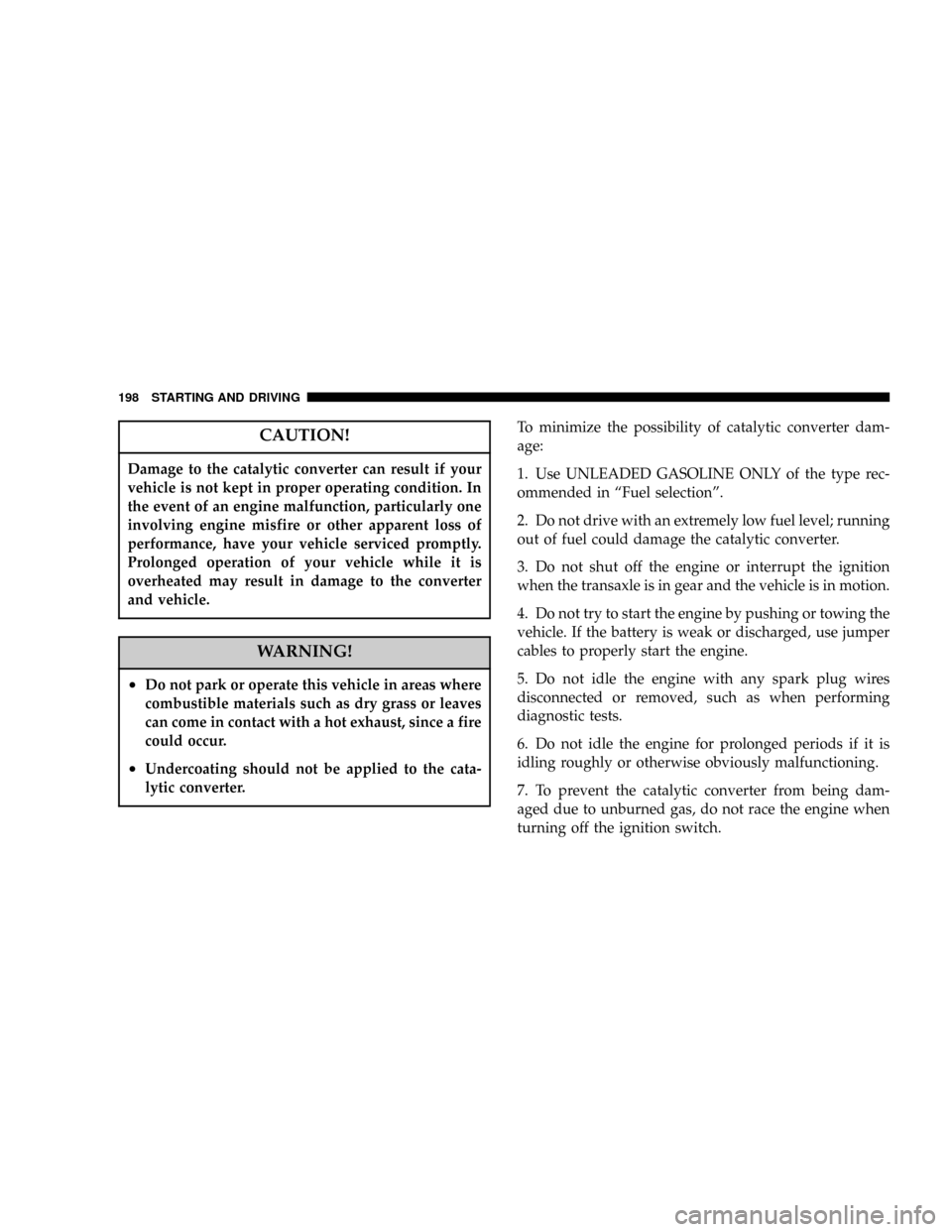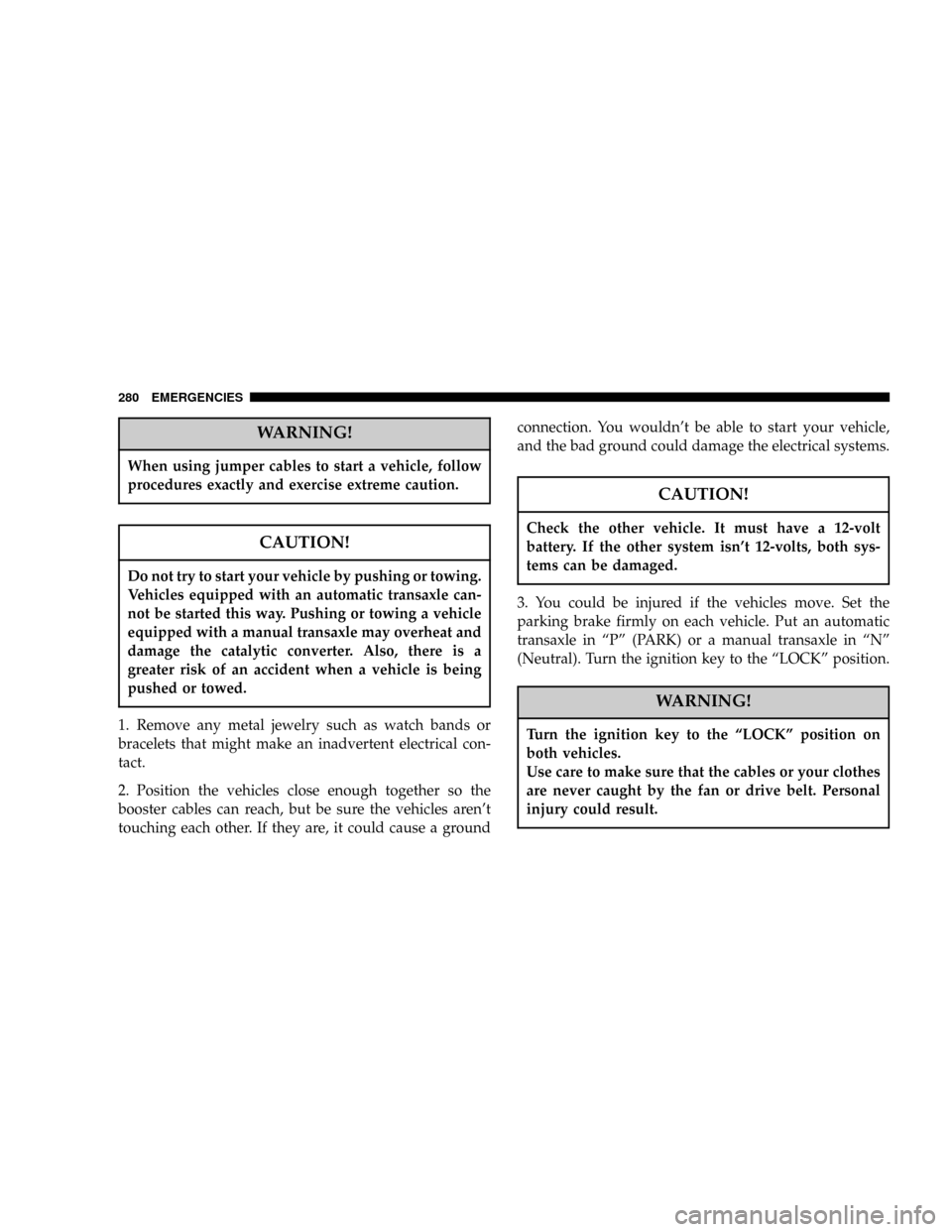towing DODGE STRATUS COUPE 2004 2.G Owners Manual
[x] Cancel search | Manufacturer: DODGE, Model Year: 2004, Model line: STRATUS COUPE, Model: DODGE STRATUS COUPE 2004 2.GPages: 388, PDF Size: 2.28 MB
Page 12 of 388

If this warning light comes on¼
Warning light Do this Ref. page
´Have the vehicle inspected at an authorized dealer as
soon as possible.P. 159
ªNº indicator light in the
instruemnt cluster flashes slowly
(once per second)
´Your vehicle will usually be drivable and not need
towing, have the engine system checked at an authorized
dealer as soon as possible.
If the vehicle is not drivable, contact Emergency
Roadside Service (ERS), authorized dealer, or local
towing company for assistance.P. 1 1 5
Malfunction indicator light
(ªSERVICE ENGINE SOONº)
SRS
´Have the air bag system checked at an authorized dealer. P. 116
Air bag warning light
´It is not necessary to stop the vehicle immediately but we
recommend that you have the system checked at an
authorized dealer as soon as possilble.
P. 1 1 8
Traction control system warning light
12 INTRODUCTION
Page 18 of 388

If this problem occurs¼
Problem Do this Ref. page
The vehicle is stuck in sand, mud, or
snow.1. Carefully rock the vehicle by shifting the transmission
from low to reverse.
WARNING
1.When attempting to rock your vehicle out of a stuck
position, be sure that no one is near the vehicle. The
rocking motion may cause the vehicle to suddenly lurch
forward or backward, and injure bystanders.
2.Avoid racing the engine or spinning the wheels.
Prolonged efforts to free a stuck vehicle may result in
overheating and transaxle failure.
If the vehicle remains stuck after several rocking
attempts, have a towing service pull the vehicle out.P. 261
The brakes are not functioning
properly after crossing a puddle or
stream.Dry out the brakes by driving slowly while lightly
depressing the brake pedal.Ð
18 INTRODUCTION
Page 115 of 388

CAUTION!
²If this light illuminates and the engine oil level is
not low, have your vehicle checked at an autho-
rized dealer.
²This warning light does not indicate the amount
of oil in the crankcase. This must be determined
by checking the oil level with the dipstick while
the engine is turned off.
Malfunction indicator light
(SERVICE ENGINE SOON)
This light is part of an onboard diagnostic
(OBD) system which monitors the emis-
sions, engine and automatic transaxle con-
trol systems. If a problem is detected in one
of these systems, this light may illuminate. Although
your vehicle will usually be drivable and not need
towing, have the system checked as soon as possible at an
authorized dealer.
This light will also illuminate for a few seconds, when the
ignition key is turned to the ªONº position. If it does not
go off after a few seconds, take the vehicle to an autho-
rized dealer.
INSTRUMENTS AND CONTROLS 115
4
Page 143 of 388

mCruise/speed control....................189
NTo activate...........................190
NTo deactivate.........................194
NTo resume the set speed.................195
mTraction control (if so equipped)...........196
mCatalytic converter.....................197
mVehicle preparation before driving..........199
NSeat belts and seats....................199
NDefrosters...........................199
NTires...............................199NLights..............................200
NFluid leaks..........................200
NDriver..............................200
mSafe driving techniques..................200
mDriving, alcohol and drugs...............201
mTips for driving in various conditions........201
mOperation during cold weather............202
mTrailer Towing.........................203
NWarranty Requirements.................203
STARTING AND DRIVING 143
5
Page 144 of 388

BREAK-IN RECOMMENDATIONS
Advanced automobile manufacturing techniques permit
you to operate your new vehicle without experiencing a
long break-in period of low-speed driving.
However, you can add to the future performance and
economy of your vehicle by observing the following
precautions during the first 300 miles (500 km).
It is recommended that you drive your vehicle at mod-
erate speeds during the break-in period.
1. Avoid racing the engine.
2. Avoid harsh driving such as fast starts, sudden accel-
eration, prolonged high-speed driving and abrupt appli-
cation of the brakes. These operations not only have a
detrimental effect on the engine but also cause increased
fuel and oil consumption, which could result in malfunc-
tion of engine components. Be particularly careful to
avoid wide-open throttle acceleration in low gear.
3. Do not overload the vehicle. Observe the seating
capacity. (See ªWeightsº page 365)
4. Do not use this vehicle for trailer towing during the
break-in period.
FUEL SELECTION
Your vehicle is designed to use unleaded gasoline only. It
is equipped with a fuel filler tube especially designed to
accept only the smaller diameter unleaded gasoline dis-
pensing nozzle.
WARNING!
Gasoline is highly flammable and explosive. You can
be burned or seriously injured when handling it.
When refueling this vehicle, always turn the engine
off and keep flames, sparks, and smoking materials
away. Always handle fuel in well-ventilated outdoor
areas.
144 STARTING AND DRIVING
Page 163 of 388

ªNº NEUTRAL
The engine may be started in this position.
WARNING!
²Never move the lever to the ªNº position while
driving since you could accidentally move the
lever into the(P(or(R(position, damaging the
transaxle.
²To prevent the vehicle from rolling when stopped
on a slope, the engine should be started in the ªPº
(PARK) position, not in ªNº (NEUTRAL).
²Always keep your foot on the brake pedal when
the vehicle is in ªNº (NEUTRAL), or when shift-
ing into or out of ªNº (NEUTRAL), to maintain
control.
ªDº DRIVE
This position is used for most city and highway driving.
Engine shifting is done automatically, depending on road
conditions.
Selector positions Manual gate Autostick
Autostick is a driver-interactive transaxle that offers
manual gear shifting capability to provide you with more
control. Autostick allows you to maximize engine brak-
ing, eliminate undesirable upshifts and downshifts, and
improve overall vehicle performance. This system can
also provide you with more control during passing, city
driving, cold slippery conditions, mountain driving,
trailer towing, and many other situations.
Whether the vehicle is stationary or in motion, Autostick
is selected by pushing the selector lever from the ªDº
position into the manual gate. To return to ªDº range
operation, push the selector lever back into the main gate.
In Autostick, gear shifts can be made rapidly by moving
the selector lever backward and forward. In contrast to a
manual transaxle, the Autostick allows gear shifts with
the accelerator pedal depressed.
STARTING AND DRIVING 163
5
Page 198 of 388

CAUTION!
Damage to the catalytic converter can result if your
vehicle is not kept in proper operating condition. In
the event of an engine malfunction, particularly one
involving engine misfire or other apparent loss of
performance, have your vehicle serviced promptly.
Prolonged operation of your vehicle while it is
overheated may result in damage to the converter
and vehicle.
WARNING!
²Do not park or operate this vehicle in areas where
combustible materials such as dry grass or leaves
can come in contact with a hot exhaust, since a fire
could occur.
²Undercoating should not be applied to the cata-
lytic converter.
To minimize the possibility of catalytic converter dam-
age:
1. Use UNLEADED GASOLINE ONLY of the type rec-
ommended in ªFuel selectionº.
2. Do not drive with an extremely low fuel level; running
out of fuel could damage the catalytic converter.
3. Do not shut off the engine or interrupt the ignition
when the transaxle is in gear and the vehicle is in motion.
4. Do not try to start the engine by pushing or towing the
vehicle. If the battery is weak or discharged, use jumper
cables to properly start the engine.
5. Do not idle the engine with any spark plug wires
disconnected or removed, such as when performing
diagnostic tests.
6. Do not idle the engine for prolonged periods if it is
idling roughly or otherwise obviously malfunctioning.
7. To prevent the catalytic converter from being dam-
aged due to unburned gas, do not race the engine when
turning off the ignition switch.
198 STARTING AND DRIVING
Page 203 of 388

WARNING!
Never open the radiator cap when the radiator is hot.
You could be seriously burned.
TRAILER TOWING
Warranty Requirements
The Manufacturer's Passenger Vehicle Warranty will
apply to vehicles used to tow trailers for non-commercial
use. However the following conditions must be met:
²The maximum trailer load for vehicles with manual
transaxles is 1,000 lbs (454 kg).
²The maximum trailer load for vehicles with automatic
transaxles is 1,000 lbs (454 kg).
²The maximum frontal area of the trailer cannot exceed
20 square feet (1.86 square meters).
²If using a manual transaxle vehicle for trailer towing,
all starts must be in FIRST gear to avoid excessive
clutch slippage.The trailer tongue load must be considered as part of the
tow vehicle load capacity when loading the vehicle.
NOTE:Check the automatic transmission fluid level
before towing. Fluid discoloration, or a burnt odor,
shows the need for transmission fluid replacement.
WARNING!
Connecting trailer brakes to your vehicle's hydraulic
brake lines can overload your brake system and
cause it to fail. You might not have brakes when you
need them and could have an accident.
Whenever you pull a trailer, regardless of the trailer size,
stop lights and turn signals on the trailer are recom-
mended for motoring safety.
STARTING AND DRIVING 203
5
Page 261 of 388

EMERGENCIES
CONTENTS
mIf the vehicle breaks down................263
NIf the engine quits.....................263
mOperation under adverse driving conditions...263
NIf your vehicle becomes stuck in sand, mud or
snow..............................263
NOnawetroad........................264
NOn snowy or icy roads..................265
mSpare tire, jack and tool set storage.........266
NHandling spare tire....................266
NJack...............................267
mCompact spare tire.....................267
mWheel covers (if so equipped).............268
mJacking and tire changing................270
NJacking up the vehicle..................270
mEngine overheating.....................278
mJump-starting the engine.................279
NIf your vehicle has anti-lock brakes.........284
mTowing..............................284
mFuses...............................286
NFuse block...........................286
mFusible links..........................287
NFuse load capacities....................287
mReplacement of light bulbs................292
NBulb capacity.........................292
8
Page 280 of 388

WARNING!
When using jumper cables to start a vehicle, follow
procedures exactly and exercise extreme caution.
CAUTION!
Do not try to start your vehicle by pushing or towing.
Vehicles equipped with an automatic transaxle can-
not be started this way. Pushing or towing a vehicle
equipped with a manual transaxle may overheat and
damage the catalytic converter. Also, there is a
greater risk of an accident when a vehicle is being
pushed or towed.
1. Remove any metal jewelry such as watch bands or
bracelets that might make an inadvertent electrical con-
tact.
2. Position the vehicles close enough together so the
booster cables can reach, but be sure the vehicles aren't
touching each other. If they are, it could cause a groundconnection. You wouldn't be able to start your vehicle,
and the bad ground could damage the electrical systems.
CAUTION!
Check the other vehicle. It must have a 12-volt
battery. If the other system isn't 12-volts, both sys-
tems can be damaged.
3. You could be injured if the vehicles move. Set the
parking brake firmly on each vehicle. Put an automatic
transaxle in ªPº (PARK) or a manual transaxle in ªNº
(Neutral). Turn the ignition key to the ªLOCKº position.
WARNING!
Turn the ignition key to the ªLOCKº position on
both vehicles.
Use care to make sure that the cables or your clothes
are never caught by the fan or drive belt. Personal
injury could result.
280 EMERGENCIES